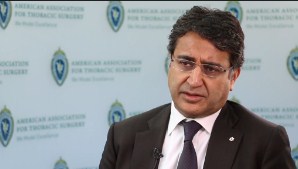User login
SEATTLE – Extracorporeal lung support (ECLS) has evolved to the point where it can keep people alive for months as they await lung transplants. There’s also an emerging role for ELS after transplant.
The technology, however, is not for everyone, according to draft guidelines from the American Association for Thoracic Surgery. They cover dozens of ins and outs about ECLS, including how to pick the right patients and how to best perform the procedure.
The technology is ever improving, so it’s possible to imagine ECLS being used for years at some point, instead of months, guideline coauthor Dr. Shaf Keshavjee, a thoracic surgeon at the University of Toronto, explained in a video interview at the annual meeting of the American Association for Thoracic Surgery.
The video associated with this article is no longer available on this site. Please view all of our videos on the MDedge YouTube channel
SEATTLE – Extracorporeal lung support (ECLS) has evolved to the point where it can keep people alive for months as they await lung transplants. There’s also an emerging role for ELS after transplant.
The technology, however, is not for everyone, according to draft guidelines from the American Association for Thoracic Surgery. They cover dozens of ins and outs about ECLS, including how to pick the right patients and how to best perform the procedure.
The technology is ever improving, so it’s possible to imagine ECLS being used for years at some point, instead of months, guideline coauthor Dr. Shaf Keshavjee, a thoracic surgeon at the University of Toronto, explained in a video interview at the annual meeting of the American Association for Thoracic Surgery.
The video associated with this article is no longer available on this site. Please view all of our videos on the MDedge YouTube channel
SEATTLE – Extracorporeal lung support (ECLS) has evolved to the point where it can keep people alive for months as they await lung transplants. There’s also an emerging role for ELS after transplant.
The technology, however, is not for everyone, according to draft guidelines from the American Association for Thoracic Surgery. They cover dozens of ins and outs about ECLS, including how to pick the right patients and how to best perform the procedure.
The technology is ever improving, so it’s possible to imagine ECLS being used for years at some point, instead of months, guideline coauthor Dr. Shaf Keshavjee, a thoracic surgeon at the University of Toronto, explained in a video interview at the annual meeting of the American Association for Thoracic Surgery.
The video associated with this article is no longer available on this site. Please view all of our videos on the MDedge YouTube channel
AT THE AATS ANNUAL MEETING
